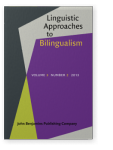Bosch, Jasmijn E. & Francesca Foppolo
Antonicelli, Giada & Stefano Rastelli
2023.
Event-related potentials in the study of L2 sentence processing: A scoping review of the decade 2010-2020.
Language Acquisition 30:2
► pp. 163 ff.

Luque, Alicia, Eleonora Rossi, Maki Kubota, Megan Nakamura, César Rosales, Cristina López-Rojas, Yulia Rodina & Jason Rothman
2023.
Morphological transparency and markedness matter in heritage speaker gender processing: an EEG study.
Frontiers in Psychology 14

Rossi, Eleonora, Sergio Miguel Pereira Soares, Yanina Prystauka, Megan Nakamura & Jason Rothman
2023.
Riding the (brain) waves! Using neural oscillations to inform bilingualism research.
Bilingualism: Language and Cognition 26:1
► pp. 202 ff.

Bosch, Jasmijn E., Mathilde Chailleux, Jia’en Yee, Maria Teresa Guasti & Fabrizio Arosio
Pereira Soares, Sergio Miguel, Tanja Kupisch & Jason Rothman
2022.
Testing Potential Transfer Effects in Heritage and Adult L2 Bilinguals Acquiring a Mini Grammar as an Additional Language: An ERP Approach.
Brain Sciences 12:5
► pp. 669 ff.

Sadeghi, Karim
2022.
Morphosyntactic Processing in SLA: An Interview with Alison Gabriele. In
Talking About Second Language Acquisition,
► pp. 105 ff.

Pereira Soares, Sergio Miguel & Jason Rothman
Shimanskaya, Elena & Tania Leal
2021.
Feature Matching Does Not Equal Convergence: Acquisition of L2 French Accusative Pronouns by L1 Spanish Speakers.
Languages 6:3
► pp. 144 ff.

González Alonso, Jorge, José Alemán Bañón, Vincent DeLuca, David Miller, Sergio Miguel Pereira Soares, Eloi Puig-Mayenco, Sophie Slaats & Jason Rothman
2020.
Event related potentials at initial exposure in third language acquisition: Implications from an artificial mini-grammar study.
Journal of Neurolinguistics 56
► pp. 100939 ff.

Shantz, Kailen & Darren Tanner
2020.
Electrophysiology finds no inherent delay for grammatical gender retrieval in non-native production.
Bilingualism: Language and Cognition 23:1
► pp. 98 ff.

DeLuca, Vincent, David Miller, Christos Pliatsikas & Jason Rothman
2019.
Brain Adaptations and Neurological Indices of Processing in Adult Second Language Acquisition. In
The Handbook of the Neuroscience of Multilingualism,
► pp. 170 ff.

Zhou, Peiyun, Susan Garnsey & Kiel Christianson
2019.
Is imagining a voice like listening to it? Evidence from ERPs.
Cognition 182
► pp. 227 ff.

Alemán Bañón, José, Robert Fiorentino, Alison Gabriele & Carrie Jackson
2018.
Using event-related potentials to track morphosyntactic development in second language learners: The processing of number and gender agreement in Spanish.
PLOS ONE 13:7
► pp. e0200791 ff.

Clahsen, Harald & Claudia Felser
2018.
SOME NOTES ON THE SHALLOW STRUCTURE HYPOTHESIS.
Studies in Second Language Acquisition 40:3
► pp. 693 ff.

Herschensohn, Julia & Randall Gess
2018.
Acquisition of L2 French Object Pronouns by Advanced Anglophone Learners.
Languages 3:2
► pp. 15 ff.

Hopp, Holger & Natalia Lemmerth
2018.
LEXICAL AND SYNTACTIC CONGRUENCY IN L2 PREDICTIVE GENDER PROCESSING.
Studies in Second Language Acquisition 40:1
► pp. 171 ff.

Paquet, Pierre-Luc
2018.
Linear Distance: A Multi-Tiered Methodology in the Acquisition of Gender Agreement.
SSRN Electronic Journal 
Roberts, Leah, Jorge González Alonso, Christos Pliatsikas & Jason Rothman
2018.
Evidence from neurolinguistic methodologies: Can it actually inform linguistic/language acquisition theories and translate to evidence-based applications?.
Second Language Research 34:1
► pp. 125 ff.

Rothman, Jason & Roumyana Slabakova
2018.
THE GENERATIVE APPROACH TO SLA AND ITS PLACE IN MODERN SECOND LANGUAGE STUDIES.
Studies in Second Language Acquisition 40:2
► pp. 417 ff.

Spinner, Patti, Rebecca Foote & Rose Acen Upor
SHIMANSKAYA, ELENA & ROUMYANA SLABAKOVA
2017.
Re-assembling objects: a new look at the L2 acquisition of pronominal clitics.
Bilingualism: Language and Cognition 20:3
► pp. 512 ff.

Zalbidea, Janire
2017.
‘One Task Fits All’? The Roles of Task Complexity, Modality, and Working Memory Capacity in L2 Performance.
The Modern Language Journal 101:2
► pp. 335 ff.

Duñabeitia, Jon Andoni, Maria Dimitropoulou, Margaret Gillon Dowens, Nicola Molinaro & Clara Martin
2016.
The Electrophysiology of the Bilingual Brain. In
Methods in Bilingual Reading Comprehension Research,
► pp. 265 ff.

Hopp, Holger
2016.
Learning (not) to predict: Grammatical gender processing in second language acquisition.
Second Language Research 32:2
► pp. 277 ff.

COUGHLIN, CAITLIN E. & ANNIE TREMBLAY
2015.
Morphological decomposition in native and non-native French speakers.
Bilingualism: Language and Cognition 18:3
► pp. 524 ff.

Rothman, Jason, José Alemán Bañón & Jorge González Alonso
2015.
Neurolinguistic measures of typological effects in multilingual transfer: introducing an ERP methodology.
Frontiers in Psychology 6

Morgan-Short, Kara
2014.
Electrophysiological Approaches to Understanding Second Language Acquisition: A Field Reaching its Potential.
Annual Review of Applied Linguistics 34
► pp. 15 ff.

Prego, Beatriz López & Alison Gabriele
This list is based on CrossRef data as of 5 july 2024. Please note that it may not be complete. Sources presented here have been supplied by the respective publishers.
Any errors therein should be reported to them.
